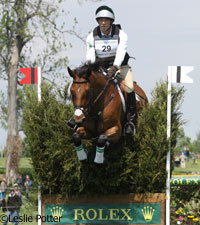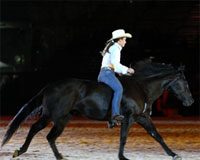 |
| Will Coleman, shown here with Twizzel at the 2012 Rolex Kentucky Three-Day Event, is advocating for new regulations on cross-country flags. Photo: Leslie Potter |
Frangible pins, foam logs and stricter rules on safety equipment use are all ways that eventing officials have worked to make the sport safer over the past few years. A new proposed rule would tackle one of the less-obvious hazards of the cross-country phase of eventing: the flags.
The horse bucked violently, flipping over and losing his rider. He then ran back to the stables with the flag still thoroughly driven through his hind end. Fortunately, veterinarians at the New Jersey Equine Clinic were able to remove the flag in pieces, and Noodle is currently recovering from the May 12 incident.
After the accident, Coleman advocated for a better flagging system, citing an incident where French competitor Icare D’Auzay, ridden by Jean-Lou Bigot, was killed at the 2007 Badminton Horse Trials in England after piercing an artery on a flag. A new rule proposed by the USEF Eventing Technical Committee would begin to solve this problem by replacing wooden flags with plastic or carbon fiber materials.
4. Safety Flags
i. The types of fence required to use safety flags include:
- a. Corners;
- b. Fences of less than 3m ( 9’8”) width;
- c. Related fences which because of their design offer a jumpable line of less than 3m (9’8”) width;
- d. Fences designed to be jumped on an angle where knocking a flag is a possibility;
ii. The flags and poles on these fences must meet the following criteria;
- a. The flag poles must be made of a material that cannot shatter, break or splinter, such as suitable plastic or carbon fiber or any other appropriate materials;
- b. There must be no points anywhere on the flag poles and any sharp corners and/or edges on the flags must be rounded;
- c. Flags must be secured in such a way that they ‘break away’ and/or move away from the fence if/when struck by either horse or rider in such a way that the chance of horse and/or rider being injured is significantly reduced.
- d. All flags and flagpoles to be used in these situations will need to be approved by the Technical Delegate.
If passed, the rule would take effect on August 1 of this year.
Read More on Eventing Safety
New Helmet Rules for Eventing and Dressage
Making Three-Day Eventing Safer
Eventing Safety Improving






Hope Noodles is doing better. These flags should have been made safer a long time ago.
I hadn’t thought about the flags as a safety issue. Anything to make the sport safer!
hope noodles get better soon
Poor “Noodle”. (love his name btw :~). i had read in the “Practical Horseman” about recent accidents. Apparently eventing is a dangerous sport. I hope that they will do all they can to make it safer, for horses and riders.
Yikes! I never would have thought the flags could be so dangerous!